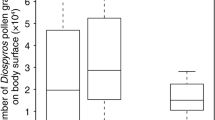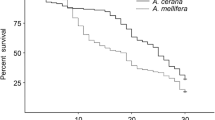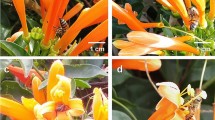Abstract
Ziziphus trees are of economic importance due to their aggregated value (source of fruits and timber) and are the most important melliferous plants in the Arabian Peninsula. Interaction between honeybees and Ziziphus nummularia was investigated by assessing foraging, flower phenology, nectar secretion, and honey potential. It is demonstrate that both the native Apis mellifera jemenitica Ruttner and the exotic Apis mellifera carnica Pollmann foraged on Z. nummularia flowers. Bee foraging for nectar and pollen was low (2 ± 0.7 workers/200 flowers/3 min) during early morning and increased to a peak in the afternoon (100 ± 15 workers/200 flowers/3 min). Remarkable foraging activity was recorded during high temperature (35°C) and low humidity (20%) conditions. Foraging for nectar collection was more distinct than that for pollen. The flowering of Z. nummularia was gradual, and was characterized by some flowers that opened and secreted nectar early before sunrise, whereas other flowers remained opened until sunrise. The flowers lasted 2 days, with 83% of nectar secreted in the first day. The peak of nectar secretion was recorded at noon under hot and dry conditions. The lowest amount of nectar was secreted during sunrise under mild temperature (24°C) and humidity (31%) conditions. Under optimum conditions, it is assumed that the average sugar mass was 0.321 ± 0.03 mg TSS/flower, while the total sugar mass was 27.65 ± 11 g/tree. The average honey production potential of tested Z. nummularia was approximately 2.998 kg/tree and 749.475 kg/ha in the main flowering season.






Similar content being viewed by others
References
Abou-Shaara HF, Al-Ghamdi AA, Mohamed AA (2012) Tolerance of two honey bee races to various temperature and relative humidity gradients. Environ Exp Biol 10:133–138
Adgaba N, Awad MA, Al-Ghamdi AA, Alqarni AS, Radloff SE (2012) Nectar of Ziziphus spina-christi (L.) Wild (Rhamnaceae): dynamics of secretion and potential for honey production. J Apic Sci 56(2):5–15
Al-Ghamdi AA (2007) Evaluation of various honeybee foraging activities for identification of potential bee plants in Riyadh, Saudi Arabia. Ann Agric Sci Fac Ain Shams Univ 52(2):487–499
Ali MAM (2011) Comparative study for evaluating two honey bee races, Apis mellifera jemenitica (indigenous race) and Apis mellifera carnica (Carniolan race) in brood production, population development and foraging activity under the environmental conditions of the central region of the Kingdom of Saudi Arabia. Ann Agric Sci Fac Agric Ain Shams Univ 56(2):127–134
Alqarni AS (2006) Tolerance of summer temperature in imported and indigenous honeybee, Apis mellifera L. races in Central Saudi Arabia. Saudi J Biol Sci 13(2):123–127
Alqarni AS, Hannan MA, Owayss AA, Engel MS (2011) The indigenous honey bees of Saudi Arabia (Hymenoptera, Apidae, Apis mellifera jemenitica Ruttner): their natural history and role in beekeeping. ZooKeys 134:83–98
Balhareth HM (2012) Comparative studies of queens and colonies of native and imported honeybees, Apis mellifera L. M. Sc. Thesis. College of Food and Agriculture Sciences, King Saud University, p 102 (in Arabic), p 103–104 (English abstract)
Bataher AS, Al-Kathery MA (2001) Non-wood products of Sidr, Ziziphus spina-christi, tree. Scientific Symposium about honey and Sidr tree. Hadramout University for Science and Technology, Faculty of Applied Sciences, Se’oun, Yemen. March 22–24, (In Arabic) p 9
Bhusal SJ, Thapa RB (2006) Response of colony strength to honey production: regression and correlation analysis. J Inst Agric Anim Sci 27:133–137
Chaudhary SA, Al-Jowaid AA (1999) Vegetation of the Kingdom of Saudi Arabia. National Agriculture & Water Research Center, Ministry of Agriculture & Water, Kingdom of Saudi Arabia, p 800
Corbet SA, Willmer PG, Beatment JWL, Unwin DM, Prys-Jones OE (1979) Post-secretory determinants of sugar concentration in nectar. Plant Cell Environ 2:293–308
Crane E, Walker P, Day R (1984) Directory of important world honey sources. International Bee Research Association London, pp 384
Dwivedi SPD, Pandey VB, Shah AH, Eckhardt G (1987) Cyclopeptide alkaloids from Ziziphus nummularia. J Nat Prod 50(2):235–237
Edge AA, Van Nest BN, Johnson JN, Miller SN, Naeger N, Boyd SD, Moore D (2012) Diel nectar secretion rhythm in squash (Cucurbita pepo) and its relation with pollinator activity. Apidologie 43:1–16
Farkas Á, Zajácz E (2007) Nectar production for the Hungarian honey industry. Eur J Plant Sci Biotech 1(2):125–151
Hammer K (2001) Rhamnaceae. In: Hanelt P, Institute of Plant Genetics and Crop Plant Research (eds) Mansfeld’s encyclopedia of agricultural and horticultural crops, vol 3. Springer, Berlin, pp 1141–1150
Hill DB, Webster TC (1995) Apiculture and forestry (bees and trees). Agrofor Syst 29:313–320
Jain SK, Tarafdar CR (1970) Medicinal plant lore of the Santhals. Econ Bot 24(3):241–278
Jakbson HB, Kristjánsson K (1994) Influence of temperature and floret age on nectar secretion in Trifolium repens L. Ann Bot 74:327–334
Jones D, Yates BD (1991) Beekeeping study notes, 2nd edn. Bee Books New and Old Tapping Wall Farm, Burrowbridge, Bridgewater TA7 ORY, Somerset, UK
Keasar T, Shmida A (2009) An evaluation of Israeli forestry trees and shrubs as potential forage plants for bees. Isr J Plant Sci 57:1–16
Khanbash MS (2003) Relationship between the density of Sidr trees, Ziziphus spina-christi, and honey production. The 3rd international conference of Arab Beekeepers Union, 28–31 December, Tanta, Egypt, p 101–108 (in Arabic), p 109 (English abstract)
Kim MS, Kim SH, Han J, Kang MS, Park YK (2011) Honeybee visit and nectar secretion characteristics of the Chinese Hawthorn, Crataegus pinnatifida Bunge. J Apic Apic Soc Korea 26(1):11–14
Kottek MJ, Grieser, Beck C, Rudolf B, Rubel F (2006) World map of the Köppen-Geiger climate classification updated. Meteorol Z 15:259–263. doi:10.1127/0941-2948/2006/0130
Mallick SA (2000) Technique for washing nectar from the flowers of Tasmanian leatherwood (Eucryphia lucida, Eucryphiaceae). Austral Ecol 25:210–212. doi:10.1046/j.1442-9993.2000.01010.x
Masierowska ML (2003) Floral nectaries and nectar production in brown mustard (Brassica juncea) and white mustard (Sinapis alba) (Brassicaceae). Plant Syst Evol 238:97–107
Nadia TL, Machado IC, Lopes AV (2007) Fenologiareprodutiva e sistema de polinização de Ziziphus joazeiro Mart. (Rhamnaceae): atuação de Apis mellifera e de visitantes floraisautóctones como polinizadores. Acta Bot Bras 21(4):835–845
Nepi M, Guarnieri M, Pacini E (2001) Nectar secretion, reabsorption, and sugar composition in male and female flowers of Cucurbita pepo. Int J Plant Sci 162:353–365
Orwa C, Mutua A, Kindt R, Jamnadass R, Simons A (2009) Agroforestree database: a tree reference and selection guide version 4.0 (http://www.worldagroforestry.org/af/treedb/)
Pandey A, Singh R, Radhamaniand J, Bhandari DC (2010) Exploring the potential of Ziziphus nummularia (Burm. f.) Wight et Arn. from drier regions of India. Genet Resour Crop Evol 57:929–936
Petanidou T, Smets E (1996) Does temperature stress induce nectar secretion in Mediterranean plants? New Phytol 133:513–518
Pham HD (2012) Pollination biology of jujubes and longans and the importance of insects in the pollination of crops in Vietnam. Ph.D. Thesis. University of Guelph, Canada
Pham-Delegue MH, Masson C, Etievant P, Azar M (1986) Selective olfactory choices among sunflower aromas, a study by combined olfactory conditioning and chemical analysis. J Chem Ecol 12:781–793
Seeley TD, Camazineand S, Sneyd J (1991) Collective decision-making in honey bees: how colonies choose among nectar sources. Behav Ecol Sociobiol 28:277–290
Silva EM, Dean BB (2004) Patterns of floral nectar production of onion (Allium cepa L.) and the effects of environmental conditions. J Am Soc Hort Sci 129(3):299–302
Szabo TI, Najda HG (1985) Flowering, nectar secretion and pollen production of some legumes in the Peace River Region of Alberta, Canada. J Apic Res 24(2):102–106
Tel-Zur N, Schneider B (2009) Floral biology of Ziziphus mauritiana (Rhamnaceae). Sex Plant Reprod 22:73–85
Weast R (ed) (1986) CRC handbook of chemistry and physics, 67th edn. CRC Press, Inc., Boca Raton
Wyatt R, Broyles SB, Derda GS (1992) Environmental influences on nectar production in milkweeds (Ascelapias syriaca and A. exaltata). Am J Bot 79:636–642
Acknowledgments
The author extends his appreciation to the Deanship of Scientific Research at King Saud University for funding this work through the research group project No. RGP-189.
Author information
Authors and Affiliations
Corresponding author
Additional information
Edited by Fernando B Noll -- UNESP
Rights and permissions
About this article
Cite this article
Alqarni, A.S. Honeybee Foraging, Nectar Secretion, and Honey Potential of Wild Jujube Trees, Ziziphus nummularia . Neotrop Entomol 44, 232–241 (2015). https://doi.org/10.1007/s13744-015-0279-4
Received:
Accepted:
Published:
Issue Date:
DOI: https://doi.org/10.1007/s13744-015-0279-4




